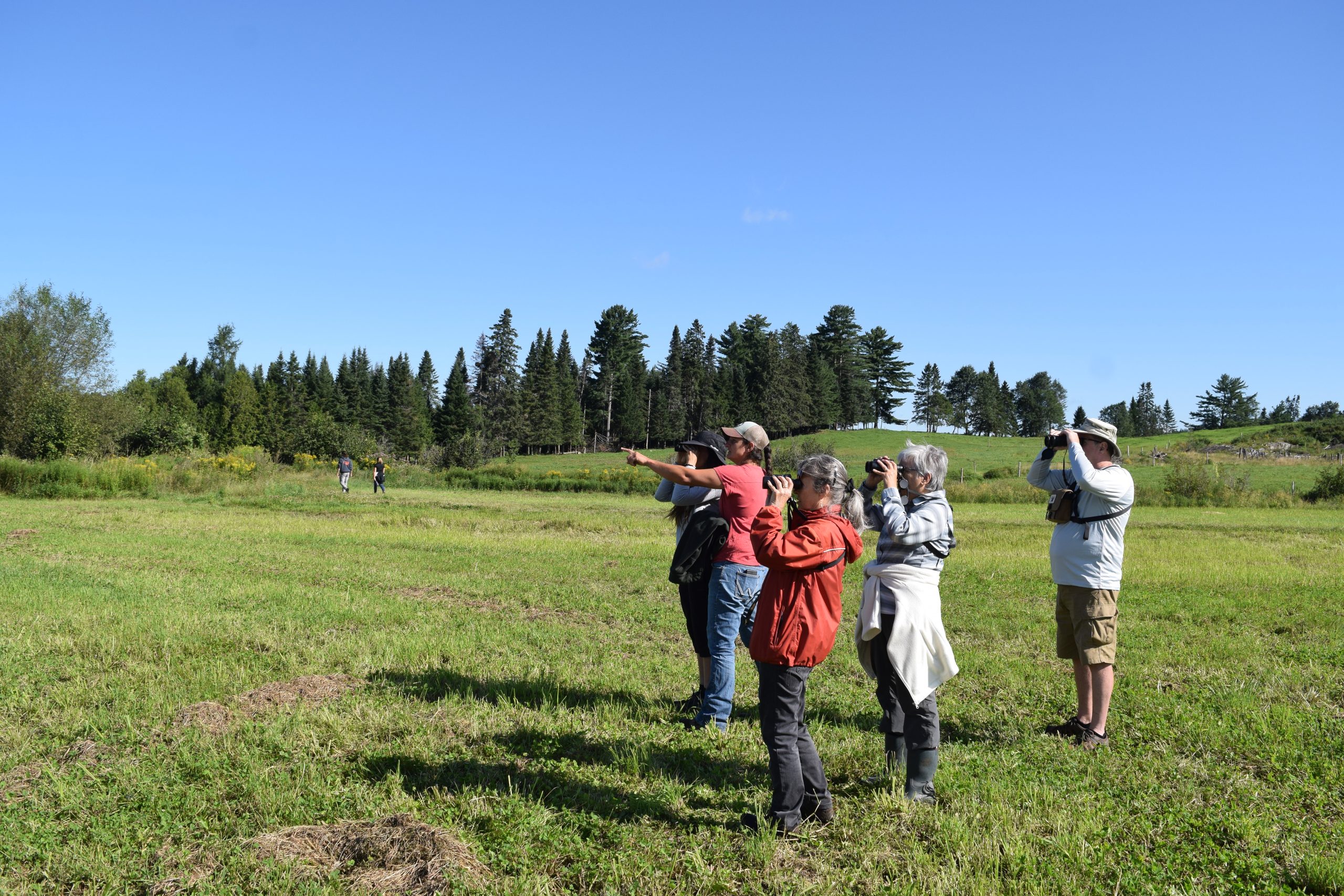Biodiversity
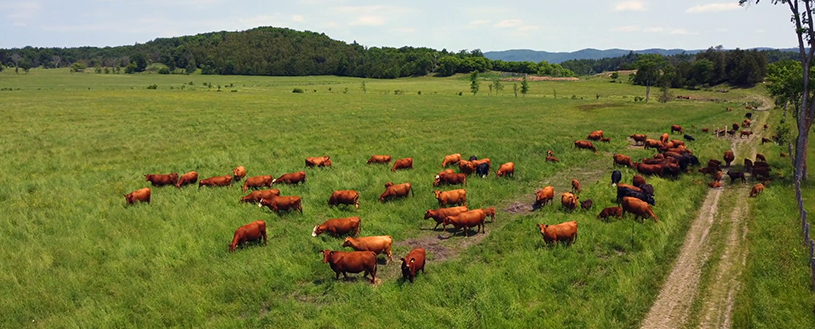
It’s a little-known fact, but the grasslands on which Quebec cattle are raised are teeming with biodiversity. Employing sustainable soil management practices (rotational grazing, optimal cattle turnout, grassland regeneration, etc.) in these environments maintains plant species, which provide natural habitats for a multitude of living creatures. This agricultural system is home to hundreds of insects and other animal species.
1. Producers stepping up for biodiversity!
Sylvain Laroche, cull cattle and dairy calf producer (Granby, Montérégie region)
When he took over Ferme Ruisselet in 2003, Sylvain Laroche’s first order of business was planting riparian buffer strips along three creeks running through his land. Years later, he finds that the increased biodiversity benefits his farm in a number of ways.
Victor Drury, feeder calf producer (La Pêche, Outaouais region)
Yes—improving biodiversity on the farm without hindering production is possible! Cattle producer Victory Drury tells how he has adopted new practices such as using flushing bars and delayed mowing to protect birds at risk.
Bertrand Anel, feeder calf producer (Cap-d’Espoir, Gaspésie region)
Bertrand Anel has made it his mission to combine productivity with his desire to improve his local landscape. Over the years, this feeder calf producer has planted a wide variety of trees and shrubs on Ferme Percé Nature. These are true agroforestry systems that bring benefits to biodiversity as well as his herd.
2. Tangible actions
In 2023, Les Producteurs de bovins du Québec (PBQ) conducted a groundbreaking survey of its members to learn more about biodiversity-friendly practices. Here are the highlights:
|
91% have a forested area on their farm |
|
|
41% have planted shelterbelts |
|
|
32% have planted trees in the last three years |
|
 |
20% have riparian buffer strips wider than the recommended three metres |
|
79% of those with pastures or grasslands practice rotational grazing |
|
|
51% have birdhouses, bat boxes, or beehives on their farms |
|
|
18% use an alternative mowing pattern to protect wildlife |
|
| 65% want to undertake biodiversity-friendly practices on their farm in the future |
Source and methodology: Biodiversity questionnaire conducted by the PBQ in summer 2023, completed by 270 respondents for a response rate of 9.44%, with a 90% confidence level and a 5% margin of error.
3. What we’re doing
What we’re doing

The PBQ received funding from the Ministère de l’Agriculture, des Pêcheries et de l’Alimentation du Québec through the Prime-Vert program to support the Programme biodiversité en production bovine (Biodiversity in cattle production program).
The project ran from March 2022 to December 2024. The goal was to train and support cattle producers to implement practices that foster habitats for wildlife, especially ground-nesting birds and pollinators, and improve biodiversity.
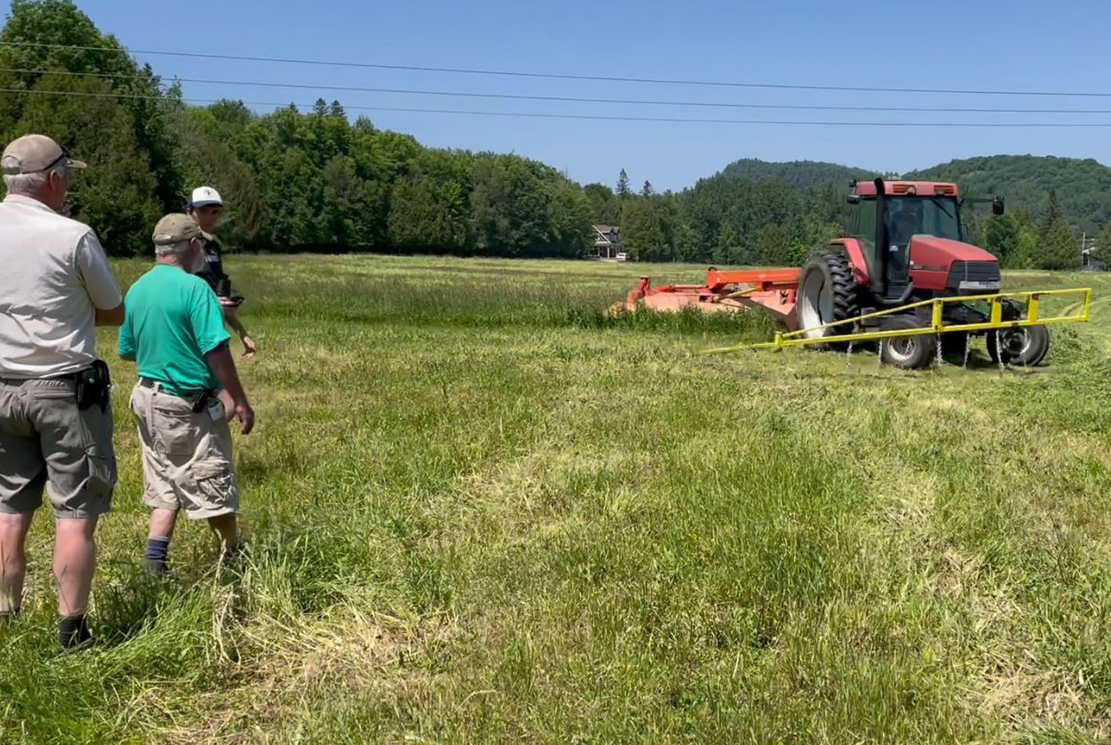 |
Mowing demonstration with a flushing bar, Outaouais region (June 2022) |
|
 |
A chick found in a field, Outaouais region (June 2022) |
Through the Programme biodiversité en production bovine, 16 information activities were organized on cattle farms. These gatherings gave attendees a chance to learn about a range of practices in cattle raising, grazing, and crop production that foster biodiversity, especially when it comes to ground-nesting birds and pollinators. Other topics covered in these events included pasture management, mowing techniques to protect birds, and delayed mowing.
 |
| Students from the Institut de technologie agroalimentaire du Québec visit Ferme Brotail for a workshop on pro-biodiversity farm setups (October 2023) |
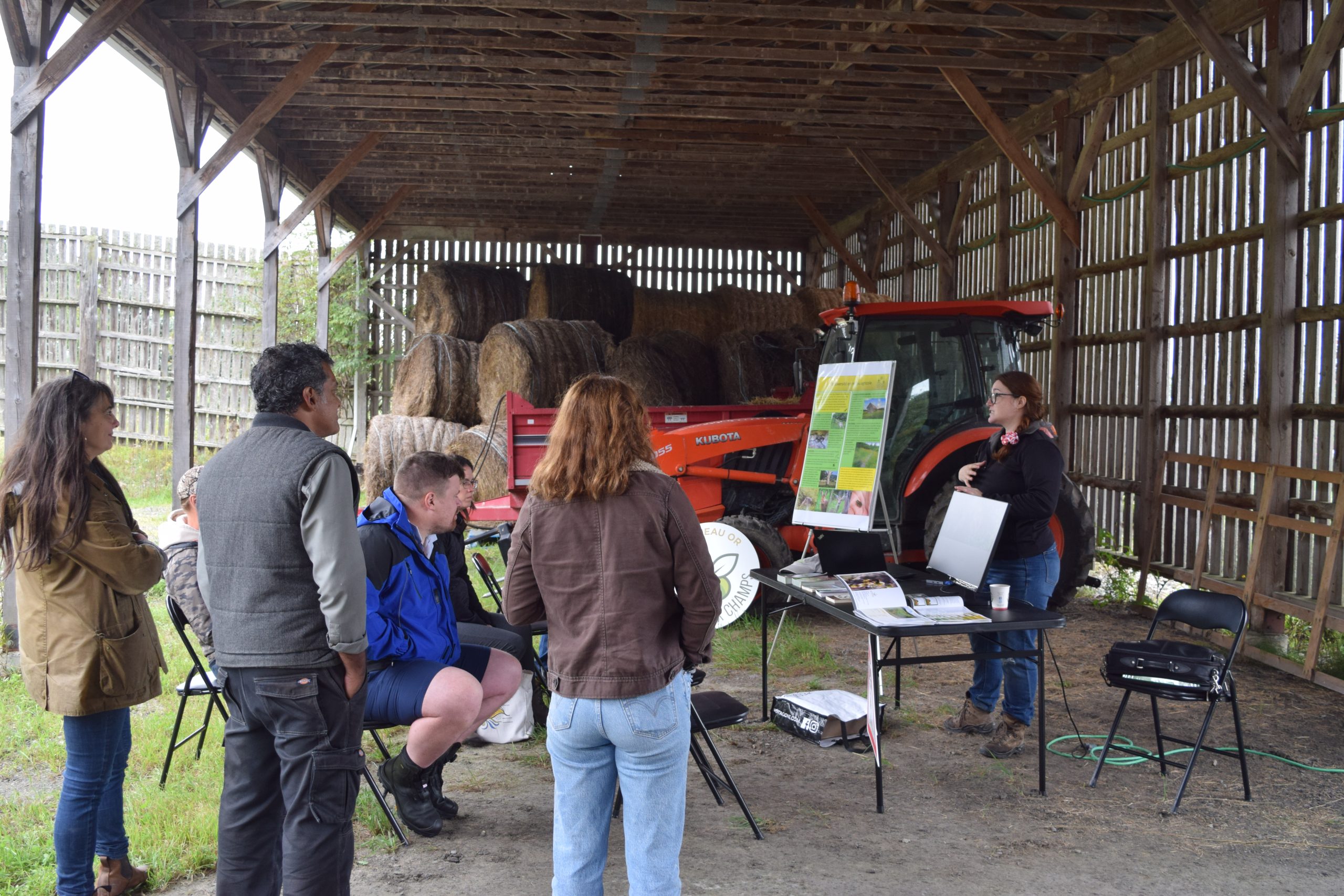 |
| A presentation about wild plants, delivered by the Gestrie-Sol club on Ferme WB (September 2023) |
|
|
| Farmers and non-farmers spotting wildlife on Ferme Écoloveau (August 2023) |
Biologists also met with producers and gave presentations on certain species at risk that dwell in agricultural systems in Quebec. These included the eastern meadowlark, the bobolink, and the western chorus frog. A total of 677 people attended events organized through this program.
Cattle producers are also involved in the ALUS communities scattered across Quebec. ALUS-supported projects are aimed at increasing biodiversity and protecting water. We invite you to visit the different ALUS community websites to find out more:
Cattle producers are also collaborators in the following bird protection projects:
- Dura-Club :
- Gestrie-Sol
- Stewardship initiative for ground-nesting birds on farms in the Green Mountains
- QuébecOiseaux: voluntary conservation of nesting habitats for ground-nesting birds in farming areas
4. Proven practices
Here are some pro-biodiversity practices available to cattle producers.
Farm installations
Extended riparian buffer strips

Riparian buffer strips are areas of land alongside streams where native plant species are planted. These plants are adapted to local conditions and provide habitat for various wild animals including birds, insects, reptiles, and mammals.
The plants in these strips also help filter contaminants (which would otherwise make their way into the water), prevent soil erosion, and regulate fluctuations in the water level. Strips may vary in width based on their location and the prevailing environmental conditions at play. A minimum width of three metres is recommended, however.
Find out more
Factsheet on extended riparian buffer strips
Flower strips

Flower strips are zones of vegetation filled with flowering plants. They are generally located at the margins of wooded areas, hedges, fields, and ditches. One purpose of these structures is to provide pollinators with shelter and food. Flower strips may also house populations of mammals or birds that play a role in pest control.
Find out more
Factsheet on promoting pollinators on farms
Birdhouses and bat boxes

Installing artificial structures is one way to provide extra nesting sites for bird species that naturally nest in holes found in dead trees and snags. These structures also attract certain insectivorous birds and birds of prey, which serve as natural enemies to crop pests. Easy-to-install structures also exist to provide shelter for bats.
Find out more
Guide to setups for ground-nesting birds
Factsheet on promoting ground-nesting birds on farms
Shelterbelts

Shelterbelts are rows of trees and/or shrubs whose primary function is to absorb wind. These structures can also have positive effects on the local environment by providing wildlife habitats, reducing soil erosion, improving water quality, and increasing biodiversity.
Find out more
Agroforestry system setup guide (paid)
Agroforestry knowledge transfer resources
Pasture, grassland, and crop practices
Rotational grazing

This practice improves pasture health and maintains biodiversity.[ii] It involves dividing pastures into sections and moving livestock from one section to another. This allows the grass to regenerate and fosters the growth of different plants. Rotational grazing also helps reduce overgrazing, which can permanently damage biodiversity levels. The grazing action of the livestock can provide an appropriate nesting site for certain birds and other wild species provided the grass height stays between 12 and 30 cm from May to July.
Find out more
Présentation sur la régie intensive des pâturages
Fiche technique sur le pâturage en rotation
Reduced livestock density
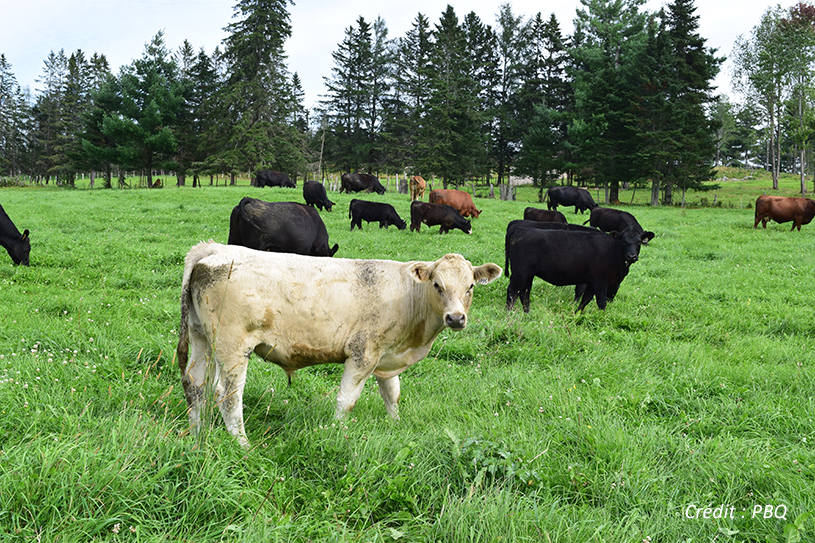
Reducing the density of livestock on pasture before July 1 gives ground-nesting birds a better environment in which to build their nests. The recommended densities are 4.2 head/hectare for cattle aged 6 months to 2 years for continuous pasture and 6.7 head/hectare for rotational grazing systems. For cattle under 6 months of age, the recommended densities are 6.3 head/hectare for continuous pasture and 10 head/hectare for rotational grazing systems.[i]
Find out more
Guide to setups for ground-nesting birds
Delayed mowing

In delayed mowing, the producer chooses a later date for mowing grasslands, generally a few weeks to one month after the usual mowing date. The purpose of this farming practice is to foster biodiversity by allowing the plants and animals in these areas to reproduce and grow before the vegetation is cut down.
Delayed mowing can provide habitat and food for many animals, including ground-nesting birds, insects, and mammals that depend on the vegetation for their survival. The literature generally recommends delaying mowing until after July 15 to encourage ground-nesting birds to build their nests.[i]
Some producers avoid mowing in certain areas to encourage species such as the bobolink; others use the presence of flowers to determine when to mow.
Find out more
Presentation on farming practices that foster ground-nesting birds
Flushing bars

A flushing bar is a tool installed at the front of a tractor. It gives chicks and female birds extra time to get out of the way of the mower. This technique is not yet widely known, and flushing bars are still hard to find on the market. However, plans are available on the Internet, and producers can have them custom-built by welders.
Find out more
Presentation on farming practices that foster ground-nesting birds
Mowing speed and pattern
 |
|
Credit: Lamoureux, S. and C. Dion, 2019. Guide de recommandations — Aménagements et pratiques favorisant la protection des oiseaux champêtres, 2nd edition. QuébecOiseaux, Montreal, 198 pages. |
Certain animals have breeding seasons that coincide with intensive farming activities. In Quebec, the riskiest period for this is from April to July. By taking certain precautions, such as reducing the mower speed to 10 km/h or using the centre-out mowing technique, farmers can limit disturbances to wildlife.
In centre-out mowing, the farmer starts at the centre of the meadow or field and makes their way to the outside edges, rather than the reverse. This gives animals the opportunity to get out of the way of the mower and to find refuge in areas that are not yet mown. Plants can also be preserved at the edge of the field, providing refuges and food for wild animals.
Centre-out mowing reduces the impacts of mowing on wild plants and animals, while fostering a diversity of habitats in meadows and fields. This can encourage the presence of rare or threatened animal and plant species, thus helping preserve biodiversity.
Find out more
Presentation on farming practices beneficial to ground-nesting birdss
[i] Lamoureux, S. et C. Dion. 2019. Guide de recommandations — Aménagements et pratiques favorisant la protection des oiseaux champêtres, 2e édition. QuébecOiseaux, Montréal, page 85
[ii] Lamoureux, S. et C. Dion. 2019. Guide de recommandations — Aménagements et pratiques favorisant la protection des oiseaux champêtres, 2e édition. QuébecOiseaux, Montréal, page 64.
5. Exploring rich biodiversity
Grasslands on Quebec cattle farms are home to at least 545 terrestrial vertebrate species, as well as many insect and plant species. Read on to explore some representatives of this flourishing biodiversity, which often play a role in ecosystem balance.
Eastern meadowlark

| Associated habitats: |
| Pastures, forage crops planted at least seven years ago, herbaceous fallow land |
| Ecologic role : |
| Natural predator of insect crop pests |
Goglu des prés

| Associated habitats: |
| Forage crops, pasture with low livestock density, herbaceous fallow land |
| Ecologic role : |
| Natural predator of insect crop pests |
Barn swallow

| Associated habitats: |
| Nests under open structures such as barns, sheds, garages, bridges; feeds above wetlands, streams, hay fields, and pastures |
| Ecologic role : |
| Natural predator of stinging insect crop pests |
Eastern bluebird

| Associated habitats: |
| Pastures, grasslands, fallow land, human structures |
| Ecologic role : |
| Natural predator of insect crop pests |
Upland sandpiper
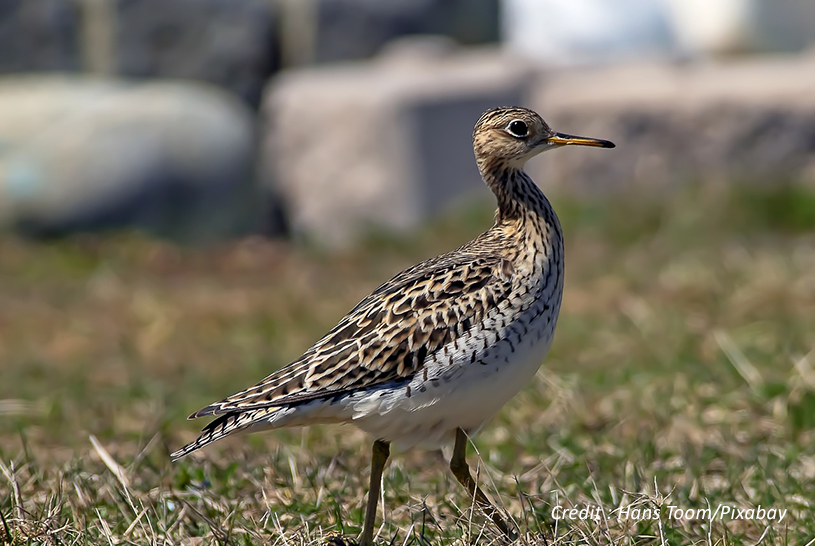
| Associated habitats: |
| Pastures, grasslands, human structures; a ground-nesting species |
| Ecologic role : |
| Natural predator of insect crop pests |
Western chorus frog

| Associated habitats: |
| Temporary shrub swamps at the edge of forests, clearings, flooded grasslands, fallow land, marshes, swamps, drainage ditches, hay fields, and pastures |
| Ecologic role : |
| Consumer of large quantities of insects, indicator of riparian habitat health in agricultural areas |
Wood turtle

| Associated habitats: |
| Meandering medium-sized streams with mostly sandy bottoms, wetlands, riparian forests, hay fields, pastures, and fallow land |
| Ecologic role : |
| Since it is omnivorous, the turtle plays a role in controlling vegetation and invertebrate populations |
Yellow-banded bumble bee
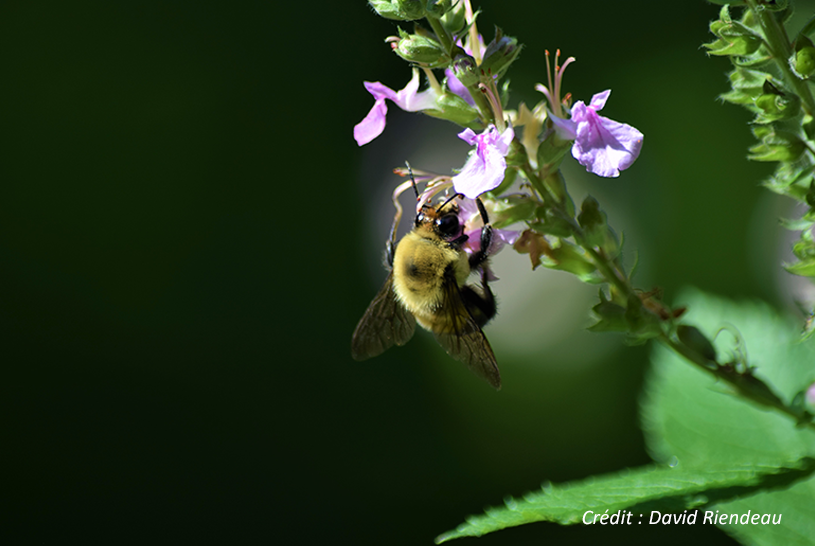
| Associated habitats: |
| Mixed forests, farmland, field edges, hay fields with abundant flowers |
| Ecologic role : |
| Essential to the reproduction of native plants, trees, and crop varieties |
Monarch butterfly
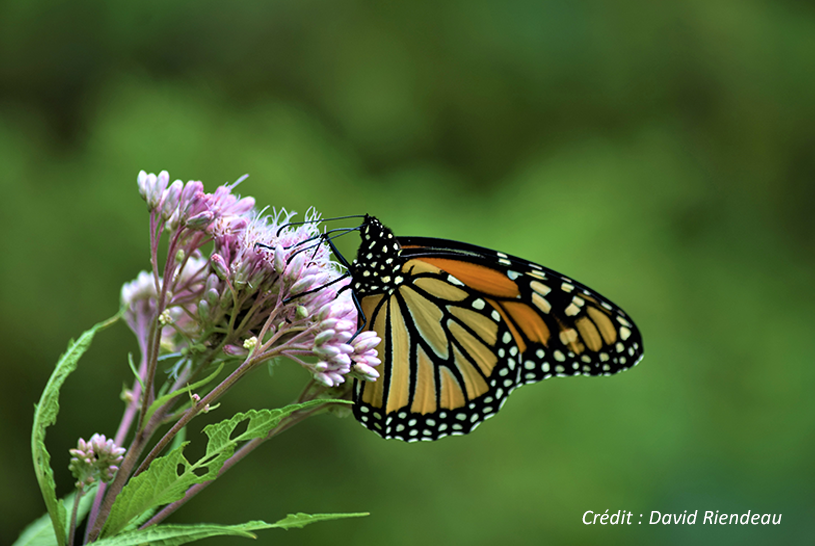
| Associated habitats: |
| Pastures, hay fields, wetlands, grassy ditches and field edges with abundant milkweed plants |
| Ecologic role : |
| Essential to the reproduction of native plants, trees, and crop varieties |
Source : Connaître pour mieux protéger (ALUS, UPA Outaouais-Laurentides), Aménagements et pratiques favorisant la protection des oiseaux champêtres (QuébecOiseaux)
 Youtube
Youtube Facebook
Facebook

